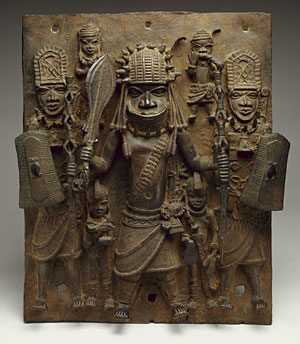
 |
|
|||||||||||||||||||||||||||||||||||||||||||||||||
 |
Ife and Benin
According to tradition it seems that a new Yoruba resurgence occurred after the advent of Oduduwa in Ile-Ife. Growing side by side and deriving inspiration from Ile-Ife were other centres of Yoruba settlement which developed into well-organized political entities known as kingdoms. |
However there was another offshoot of the growth and influence of Ile-Ife. That was the kingdom of Benin. The religious, political and artistic influence of the founding city of the new Yoruba renaissance was embraced by Benin in a manner unequalled by the other developing kingdoms. From around the 10th century onwards the Benin developed works of art that in many ways equalled those of Ile-Ife the very place that was the source of its inspiration. Later at around the 14th century the Royal Court of Benin commissioned various works of art to extol its power, mystique and grandeur, works that have become centrepieces of various exhibitions in modern museums. These works are also displayed all around the website for any to see. The magnificence and splendour of Benin was described most eloquently when visited by a Dutchman in 1602 who attests that: ‘The town seemeth to be great; when you enter into it, you go into a great broad street, not paved, which seems to be seven or eight times broader than the Warmoes street in Amsterdam. It is thought that the street is a mile long (a Dutch mile is roughly equal to for English ones) besides the surburbs… when you are in the great street aforesaid, you see many great streets on the sides thereof, the houses in this town stand in good order, one close and even with the other as the houses in Holland stand…' The Kingship of Benin is closely related to Ife. In Benin tradition it was believed that a descendent of Oduduwa, a prince from Ile-Ife named Oranmiyan founded the monarchy of Benin. The first ‘Oba' King was said to be his son Ewaki I. Oduduwa was also an integral character in many of Benin 's oral traditions. The link between the Benin and Yoruba were very deep indeed. And it seems that the influence of one over the other through the course of history in times of both peace and war was ever present. Even though the Benin spoke a language distinct from Yoruba (Edo), the historical similarities between the Yoruba and Benin are such that the religious, political, artistic and linguitic resemblances still lingers till this day. The Forest Kingdoms of the Yoruba
New kingdoms were founded or consolidated by people who claimed connection with Ife. This process began in earnest about the late 13th or early 14th century or a little earlier and continued in a few cases until the 17th century. The oldest of these was the kingdom of Owu. Its first king was said to be Asunkungbade whose mother was, according to tradition, the eldest child of Oduduwa. Ofcourse if this tradition was true this would date the time of Oduduwa to around the 12th century at the earliest. But the dating of the time of Oduduwa can only be pure speculation as the conflict in the stories of the traditions were so striking.
|